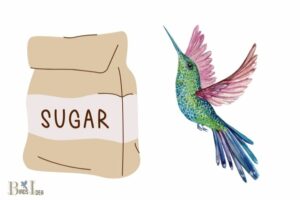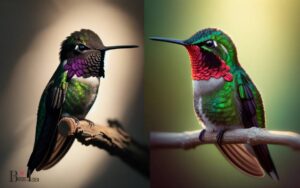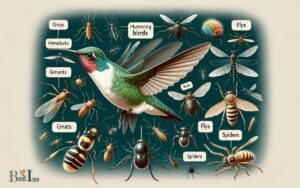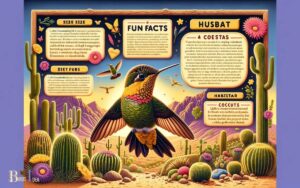Ruby Throated Hummingbird Food Chain: A Vital Pollinator!
The Ruby-throated Hummingbird, a vital pollinator, relies on nectar for energy and insects for protein, forming an essential link in its food chain.
Predatory threats and habitat destruction necessitate focused conservation to maintain ecological balance.
The Ruby-throated Hummingbird occupies a niche within its food chain that supports not only its species but also the health of its ecosystem.
The food chain consists of:
The Ruby-throated Hummingbird’s survival and ecological role depend on a balanced food chain and habitat conservation.
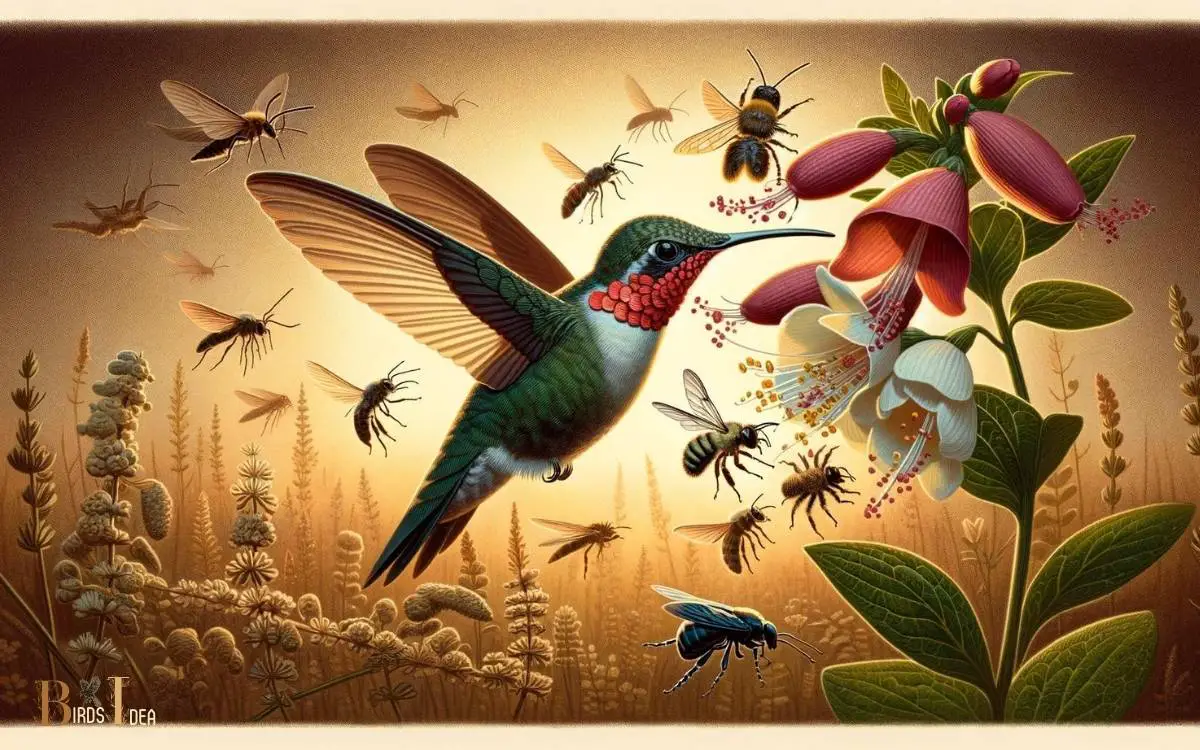
Key Takeaway
4 Trophic Levels: Ruby-throated Hummingbird Food Chain
| Trophic Level | Organisms Involved | Description |
|---|---|---|
| Primary | Flowering Plants | Provide nectar, the main energy source for Ruby-throated Hummingbirds. |
| Secondary | Insects & Spiders | Serve as protein sources for the hummingbirds; also include potential predators. |
| Tertiary | Birds of Prey | Include predators of the Ruby-throated Hummingbird, such as hawks and larger birds. |
| Quaternary | Humans & Environment | Impact the food chain through habitat alteration, pesticide use, and climate change. |
Ruby-Throated Hummingbird Diet
The Ruby-throated hummingbird primarily sustains itself by feeding on flower nectar, insects, and tree sap. As a nectarivorous species, the hummingbird plays a crucial role in pollination, as it obtains nectar from a variety of flowering plants.
Their long, specialized beaks and tongues enable them to reach deep into flowers to access nectar. In addition to nectar, they also consume a wide range of insects, including mosquitoes, fruit flies, and gnats, which provide essential protein and fats in their diet.
Furthermore, the hummingbird occasionally feeds on tree sap, utilizing sap wells created by sapsuckers or accessing sap that oozes from damaged trees.
This diverse diet ensures that the Ruby-throated hummingbird obtains the necessary nutrients for its high-energy lifestyle, contributing to its survival and ecological significance.
Nectar as Primary Food Source
The consumption of nectar is a critical component of the diet of the Ruby-throated hummingbird, serving as its primary food source.
Nectar provides the necessary energy and nutrients for the hummingbird’s high metabolic rate and constant activity.
The interaction between hummingbirds and the plants they pollinate is a vital aspect of the ecosystem, influencing plant reproduction and diversity.
Hummingbirds and Nectar
An essential component of the ruby-throated hummingbird’s diet is nectar, which serves as their primary food source.
Hummingbirds have a remarkable adaptation to feed on nectar from flowers. Their long, specialized beaks and extendable, tube-like tongues allow them to reach deep into flowers to extract nectar.
Nectar is a sugary fluid found in the flowers of plants, and it provides the hummingbirds with the energy they need for their high metabolism. The high sugar content of nectar fuels their incredibly fast wingbeats, allowing them to hover and move with agility.
Hummingbirds have developed a strong attraction to brightly colored, tubular flowers, which are well-suited to their feeding mechanism.
This specialized feeding behavior has made them effective pollinators for many flowering plants, thus establishing a mutualistic relationship within their ecosystem.
Plant-Pollinator Interactions
When considering the ruby-throated hummingbird’s diet, it is crucial to understand the role of plant-pollinator interactions, with nectar serving as the primary food source.
Hummingbirds play a vital role in plant-pollinator interactions as they act as efficient pollinators while obtaining nectar from flowers.
The relationship between hummingbirds and the plants they feed on is mutually beneficial; the bird receives nectar, a high-energy food source, while inadvertently transferring pollen from one flower to another, aiding in the plants’ reproduction.
This intricate interaction forms the basis of the hummingbird’s diet and the survival of many flowering plant species.
Below is a table highlighting some common plants and the corresponding nectar characteristics that attract ruby-throated hummingbirds.
| Plant Species | Nectar Color | Nectar Volume |
|---|---|---|
| Trumpet Vine | Red | Medium |
| Bee Balm | Pink | High |
| Cardinal Flower | Orange | Low |
| Columbine | Yellow | Medium |
| Coral Honeysuckle | Orange | High |
Insect and Spider Consumption
A significant portion of the Ruby Throated Hummingbird’s diet consists of small insects and spiders. These tiny creatures, such as gnats, fruit flies, and small spiders, provide essential protein and nutrients for the hummingbird’s survival and energy needs.
The hummingbird’s remarkable agility and hovering ability allow it to capture insects in mid-air or pluck them from leaves and spider webs. They use their long, specialized bills to reach into crevices and flowers to extract spiders and insects.
This behavior not only supplements their nectar-based diet but also ensures a diverse nutrient intake.
Observations have shown that hummingbirds are particularly attracted to areas with high insect activity, indicating the importance of this food source in their foraging behavior and overall ecological niche.
Role in Pollination
Playing a vital role in pollination, the Ruby Throated Hummingbird contributes to the ecosystem by transferring pollen from flower to flower as it seeks out nectar and insects.
As the hummingbird hovers near flowers to feed on nectar, its head and bill come into contact with the reproductive parts of the flower, picking up and depositing pollen.
This transfer of pollen between flowers facilitates fertilization and the production of seeds, contributing to the reproductive success of flowering plants.
The Ruby Throated Hummingbird’s long, slender bill and specialized tongue allow it to access nectar deep within the flowers, increasing the likelihood of pollen transfer.
This mutualistic relationship between the hummingbird and flowering plants is essential for maintaining biodiversity and the stability of ecosystems.
Predators and Threats
The Ruby-throated hummingbird faces a range of natural predators, including larger birds, snakes, and insects.
Additionally, human-related threats such as habitat loss, pesticides, and collisions with man-made structures also pose significant risks to the survival of these delicate creatures.
Understanding the dynamics of these predators and threats is crucial for the conservation of the Ruby-throated hummingbird population.
Natural Predators of Hummingbirds
Discussing natural predators and threats to hummingbirds is essential for understanding their place in the ecosystem. Despite their agility and speed, hummingbirds are vulnerable to predation.
Common natural predators of hummingbirds include larger birds of prey such as hawks, falcons, and owls.
These raptors have keen eyesight and are capable of capturing hummingbirds in flight. Snakes are another threat, as they can climb trees and raid nests for eggs or even capture adult hummingbirds.
Additionally, domestic cats pose a significant risk to hummingbirds, especially when the birds are feeding or resting near the ground.
Understanding these natural predators is crucial for conservation efforts aimed at protecting hummingbird populations.
Human-Related Threats to Hummingbirds
While natural predators pose a threat to hummingbirds, human-related threats also significantly impact the delicate creatures’ survival.
These threats include:
Habitat Loss:
- Deforestation and urbanization lead to the destruction of the hummingbirds’ natural habitats.
- This loss of habitat reduces available nesting sites and food sources, impacting their ability to survive and reproduce.
Pesticide Use:
- The use of pesticides in agriculture can contaminate the nectar and insects that hummingbirds rely on for nutrition.
- Exposure to pesticides can weaken hummingbirds, making them more susceptible to diseases and affecting their reproductive success.
Climate Change:
- Changing climate patterns can alter the availability of nectar-producing flowers and disrupt the timing of hummingbird migration and breeding.
These human-related threats pose significant challenges to the conservation of hummingbird populations.
Conservation Efforts
Numerous conservation efforts have been implemented to protect the delicate balance of the Ruby Throated Hummingbird food chain.
These efforts aim to safeguard the habitats, food sources, and nesting grounds crucial for the survival of these fascinating creatures.
The table below outlines key conservation strategies and their impact:
| Conservation Effort | Description | Impact |
|---|---|---|
| Habitat Preservation | Protection of natural habitats | Ensures availability of food sources and nesting sites |
| Native Plant Promotion | Encouraging growth of native flora | Provides essential nectar sources for hummingbirds |
| Reducing Pesticide Use | Limiting harmful chemical exposure | Minimizes health risks and ensures a safe food supply |
| Public Awareness Campaign | Educating communities about conservation | Promotes support and involvement in hummingbird conservation |
These conservation efforts are crucial for maintaining the delicate balance of the Ruby Throated Hummingbird food chain and preserving their populations for future generations.
Conclusion
The ruby-throated hummingbird primarily consumes nectar as its main food source, supplemented by insects and spiders. This unique diet plays a crucial role in pollination, contributing to the health and diversity of plant species.
However, these tiny birds face threats from predators and habitat loss. Conservation efforts are essential to protect the delicate balance of the ruby-throated hummingbird food chain.
Interestingly, a single hummingbird may consume up to twice its body weight in nectar every day, demonstrating their remarkable energy needs.


